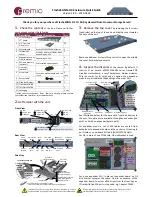
22: Configuring Routing Information Protocol (RIP)
_______________________________________________________________________________________________________
_______________________________________________________________________________________________________
© Virtual Access 2018
GW1000 Series User Manual
Issue: 2.3
Page 197 of 463
22
Configuring Routing Information Protocol (RIP)
22.1
Introduction
RIP is a dynamic routing algorithm used on IP-based internet networks.
A distance-vector routing algorithm is used by RIP to assist in maintaining network
convergence. It uses a metric or ‘hop’ count as the only routing criteria. Each route is
advertised with the number of hops a datagram would take to reach the destination
network. The maximum metric for RIP is 15. This limits the size of the network that RIP
can support. Smaller metrics are more efficient-based on the cost associated with each
metric.
RIP protocol is most useful as an Interior Gateway Protocol (IGP). An IGP refers to the
routing protocol used within a single autonomous system. There may be a number of
autonomous systems, using different routing protocols, combined together to form a
large network.
In most networking environments, RIP is not the preferred choice for routing as its time
to converge and scalability are poor compared to EIGRP or OSPF.
22.1.1
RIP characteristics
RIP is a standardised distance vector protocol, designed for use on smaller networks. RIP
was one of the first true distance vector routing protocols, and is supported on a wide
variety of systems.
RIP adheres to the following distance vector characteristics:
•
RIP sends out periodic routing updates, every 30 seconds
•
RIP sends out the full routing table every periodic update
•
RIP uses a form of distance as its metric, in this case, hopcount
•
RIP uses the Bellman-Ford distance vector algorithm to determine the best path
to a particular destination
Other characteristics of RIP include:
•
RIP supports IP and IPX routing
•
RIP utilizes UDP port 520
•
RIP routes have an administrative distance of 120
•
RIP has a maximum hopcount of 15 hops. Any network that is 16 hops away or
more is considered unreachable to RIP, thus the maximum diameter of the
network is 15 hops. A metric of 16 hops in RIP is considered a poison route or
infinity metric.
If multiple paths exist to a particular destination, RIP will load balance between those
paths, by default, up to 4, only if the metric (hopcount) is equal. RIP uses a round-robin
system of load-balancing between equal metric routes, which can lead to pinhole
congestion.
















































